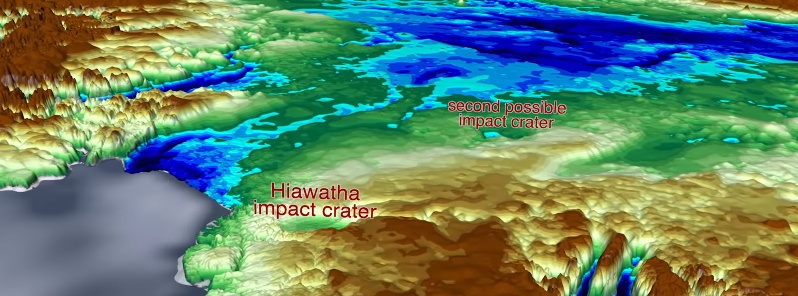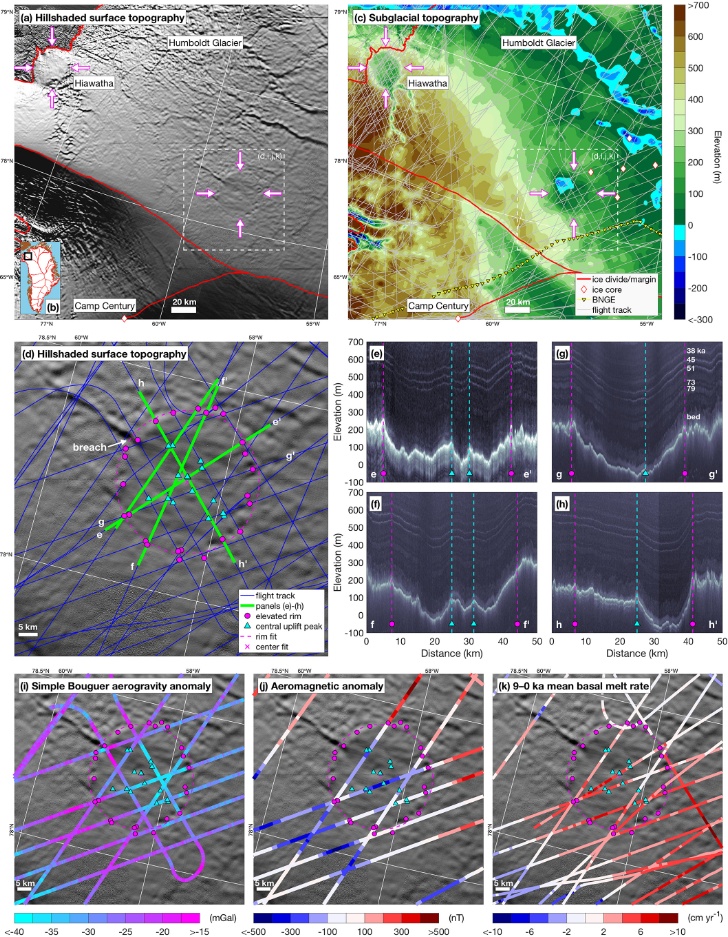Second meteorite impact crater found under Greenland ice

A new study published this week in AGU's Geophysical Research Letters suggests a second meteorite impact crater was found deep under ice in northwestern Greenland. The discovery comes just several months after scientists identified another similar crater beneath Greenland's Hiawatha Glacier – the first impact crater ever discovered under Earth's ice sheets.
The new crater is 36.5 km (22.7 miles) wide and buried under 2 km (1.2 miles) of ice, 183 km (113.7 miles) southeast of the Hiawatha impact crater. If confirmed, this will be the second known crater under Earth's ice sheets and the 22nd largest crater on Earth.

(a) Hillshaded ArcticDEM surface elevation across northwestern Greenland, showing both the Hiawatha impact crater along the ice margin and the presently identified structure farther inland to the southeast. Horizontal lines across the panel are mosaicking artifacts. Magenta arrows indicate location of both structures. Ice divides and margin are from Zwally et al. (2012) and Howat et al. (2014), respectively. Locations of 1953–1954 British North Greenland Expedition (BNGE) traverse stations, 1959–1967 Camp Century station, and 1995 Humboldt Glacier shallow ice core sites are from Paterson (1955), Colgan et al. (2016) and Mosley‐Thompson et al. (2001), respectively. Location of panels (d), (i), (j), and (k), supporting information Figure S1 and Movies S1 and S2, shown as white dashed box. (b) Map of Greenland with black box showing location of panels (a) and (c). (c) Gridded subglacial topography across northwestern Greenland (Morlighem et al., 2017; Kjær et al., 2018). The 1993–2017 NASA and 2016 Alfred Wegener Institute (AWI) flight tracks are from Leuschen (2018) and Kjær et al. (2018), respectively. (d) Hillshaded ArcticDEM in the vicinity of possible second impact crater, with overlain radar‐identified features (elevated rim and peaks in central uplift) and best fit circle to rim identifications. A breach in the western portion of the rim is highlighted. (e–h) Selected radargrams over the possible impact crater from 14 May 1999, 5 May 2014, 16 May 2012, and 17 April 2017, respectively. Vertical dashed lines indicate identified elevated rim and peaks in the central uplift. In (g), the ages of five prominent deep reflections (MacGregor et al., 2015), and the ice bed reflection are identified. (i) Simple Bouguer aerogravity anomaly, (j) aeromagnetic anomaly (not reduced to pole), and (k) 9‐ to 0‐ka mean basal melt rate over the second possible impact crater. Credit: Authors, AGU/Geophysical Research Letters
The structure's rim induces a conspicuously circular surface expression, it possesses a central uplift, and it causes a negative gravity anomaly – properties consistent with an impact origin.
"We conclude that the identified structure is very likely an impact crater," scientists said in an abstract of their study published February 11, 2019 in Geophysical Research Letters.
"The only other circular structure that might approach this size would be a collapsed volcanic caldera," lead author Joe MacGregor said. "But the areas of known volcanic activity in Greenland are several hundred miles away. Also, a volcano should have a clear positive magnetic anomaly, and we don’t see that at all."

The new and Hiawatha craters are similarly sized, but the candidate second crater appears more eroded and ice above it is much less disturbed than above the Hiawatha impact crater.
From the same radar data and ice cores that had been collected nearby, MacGregor and his colleagues determined that the ice in the area was at least 79 000 years old. The layers of ice were smooth, suggesting the ice hadn’t been strongly disturbed during that time. This meant that either the impact happened more than 79 000 years ago or – if it took place more recently – any impact-disturbed ice had long ago flowed out of the area and been replaced by ice from farther inland.
The researchers then calculated that a crater of that size would have initially been more than 800 m (0.5 miles) deep between its rim and floor, which is an order of magnitude greater than its present depth. Taking into account a range of plausible erosion rates, they calculated that it would have taken anywhere between roughly a hundred thousand years and a hundred million years for the ice to erode the crater to its current shape – the faster the erosion rate, the younger the crater would be within the plausible range, and vice versa.
"The ice layers above this second crater are unambiguously older than those above Hiawatha, and the second crater is about twice as eroded," MacGregor said. "If the two did form at the same time, then likely thicker ice above the second crater would have equilibrated with the crater much faster than for Hiawatha."
MacGregor is a glaciologist with NASA’s Goddard Space Flight Center in Greenbelt, Maryland, who participated in both findings.
Reference
A Possible Second Large Subglacial Impact Crater in Northwest Greenland – Joseph A. MacGregor, William F. Bottke Jr., Mark A. Fahnestock, Jeremy P. Harbeck, Kurt H. Kjær, John D. Paden, David E. Stillman, Michael Studinger – AGU – Geophysical Research Letters – February 11, 2019 – https://doi.org/10.1029/2018GL078126
Featured image credit: NASA/Goddard

Commenting rules and guidelines
We value the thoughts and opinions of our readers and welcome healthy discussions on our website. In order to maintain a respectful and positive community, we ask that all commenters follow these rules.